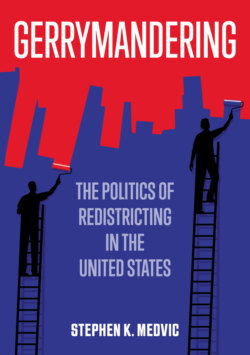Gerrymandering

Реклама. ООО «ЛитРес», ИНН: 7719571260.
Оглавление
Stephen K. Medvic. Gerrymandering
CONTENTS
Guide
List of Figures
List of Tables
Pages
Gerrymandering. The Politics of Redistricting in the United States
Acknowledgements
CHAPTER 1 What’s the Problem?
The Need to Draw District Boundaries
Fair Elections
Representation
Plan of the Book
Conclusion
Notes
CHAPTER 2 A Brief History of Gerrymandering
Districts in Early American History
Redistricting in the Mid- to Late Nineteenth Century
Redistricting in the Early to Mid-Twentieth Century
Conclusion
Notes
CHAPTER 3 The Legal Status of Gerrymandering
The Apportionment Cases
Racial Gerrymandering Cases
Partisan Gerrymandering Cases
Conclusion
Notes
CHAPTER 4 How Gerrymandering Works
Who is Responsible for Drawing the Maps?
Redistricting Criteria
How Redistricting is Done
How to Gerrymander Districts
Conclusion
Notes
CHAPTER 5 The Consequences of Gerrymandering
The Effect on Candidates and Parties
Competition
Partisan Advantage
Incumbency Advantage
The Effect on Voters
Voter Turnout
Vote Choice
Polarization
Conclusion
Notes
CHAPTER 6 Reform Proposals
Bureaucratic Redistricting – The “Iowa Model” and Missouri’s (Short-Lived) State Demographer
Independent Redistricting Commissions and Public Involvement
Multimember Districts
Conclusion
Notes
Further Reading
Bibliography
Index. A
B
C
D
E
F
G
H
I
J
K
L
M
N
O
P
R
S
T
U
V
W
Y
Z
POLITY END USER LICENSE AGREEMENT
Отрывок из книги
Stephen K. Medvic
I owe the greatest debt of gratitude to my wife, Laura. As I worked on this book, I was constantly inspired by the grace with which she handles her work as Registrar of Franklin & Marshall College, the graduate classes she’s taking, and all the other responsibilities she has on her plate. Her energy is infectious and I can’t imagine facing life’s challenges without her love and encouragement.
.....
is to view appropriate democratic politics as akin in important respects to a robustly competitive market – a market whose vitality depends on both clear rules of engagement and on the ritual cleansing born of competition. Only through an appropriately competitive partisan environment can one of the central goals of democratic politics be realized: that the policy outcomes of the political process be responsive to the interests and views of citizens. But politics shares with all markets a vulnerability to anticompetitive behavior. In political markets, anticompetitive entities alter the rules of engagement to protect established powers from the risk of successful challenge.35
Gerrymandering, of course, is the quintessential anticompetitive tactic. Drawing on the theory of political competition, Issacharoff finds problematic even a legislative map that is mutually agreed upon by both parties if that map gives the parties a distinct electoral advantage in their respective districts. This, he argues, causes voters harm based on the “constriction of the competitive process by which voters can express choice.”36 Issacharoff analogizes the collusive behavior of these parties to companies, say Coke and Pepsi, that agree to sell their products in different geographical regions to avoid competing with one another. Such an agreement would be illegal on antitrust grounds. Partisan cartels, he maintains, should be treated similarly.37
.....